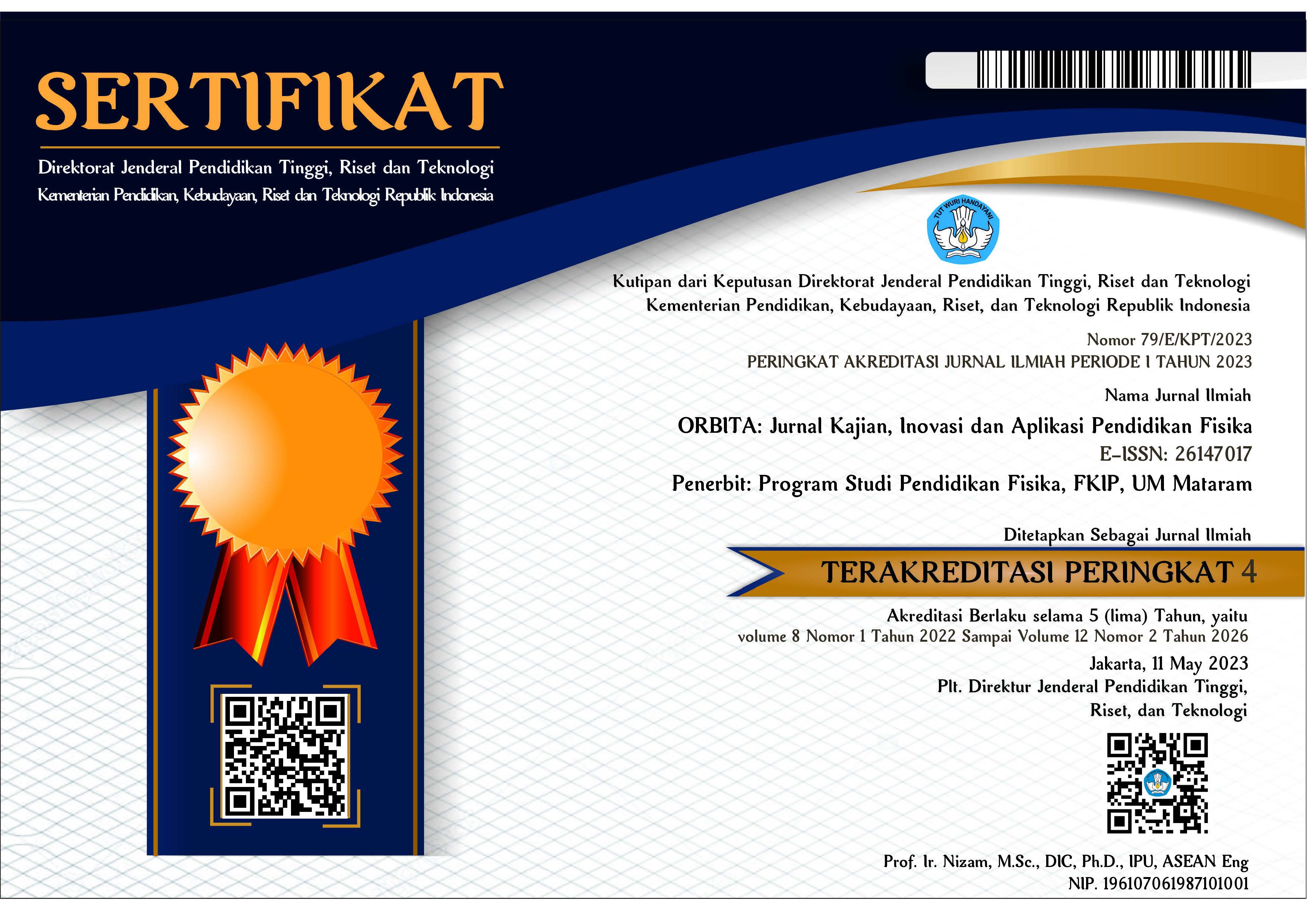ANALISIS SUSEPTIBILITAS MAGNETIK TANAH TPA ANTANG MAKASSAR BERDASARKAN KEDALAMAN
Abstract
ABSTRAK
Analisis suseptibilitas magnetik pada tanah di TPA Antang Makassar berdasarkan kedalaman telah dilakukan. Studi ini bertujuan untuk menganalisis jenis mineral magnetik, domain magnetik, dan sumber mineral magnetik. Suseptibilitas magnetik diukur menggunakan alat Bartington MS2 Magnetic Susceptibility Meter dengan sensor MS2B yang bekerja pada dua frekuensi. Pengukuran suseptibilitas magnetik dilakukan dengan mengambil sampel pada lima titik dengan variasi kedalaman hingga 0-80 cm dari permukaan tanah. Hasil pengukuran menunjukkan bahwa nilai suseptibilitas magnetik di TPA Antang bervariasi 2,097 m3/kg hingga 33,523 m3/kg dan suseptibilitas magnetik bergantung frekuensi pada rentangan 2,51% hingga 6,51%. Sampel tanah diindikasikan mengandung mineral magnetik yang bersifat antiferomagnetik dan paramagnetik. Domain magnetik pada sampel tanah adalah superparamagnetik (SP) dan stable single domain (SSD). Sumber mineral magnetik dominan berasal dari aktivitas manusia (antropogenik).
Kata kunci: TPA; tanah; suseptibilitas magnetik; mineral magnetik; antropogenik.
ABSTRACT
Magnetic susceptibility analysis of soil at TPA Antang Makassar based on depth has been carried out. This study aims to analyze the types of magnetic minerals, magnetic domains, and sources of magnetic minerals. Magnetic susceptibility was measured using a Bartington MS2 Magnetic Susceptibility Meter with an MS2B sensor that works on two frequencies. Magnetic susceptibility measurements were carried out by taking samples at five points with depth variations up to 0-80 cm from the ground surface. Measurement results show that the magnetic susceptibility values in Antang landfill varied from 2.097 m3/kg to 33.523 m3/kg and the magnetic susceptibility was frequency dependent in the range of 2.51% to 6.51%. Soil samples are indicated to contain magnetic minerals that are antiferromagnetic and paramagnetic. The magnetic domains in the soil samples are superparamagnetic (SP) and stable single domain (SSD). The dominant source of magnetic minerals comes from human activities (anthropogenic).
Keywords: landfill; soil; magnetic susceptibility; magnetic mineral; anthropogenic.
Keywords
Full Text:
PDFReferences
Arsyad, M., Tiwow, V. A., Rampe, M. J., & Rampe, H. L. (2022). Relationships of Magnetic Properties and Heavy Metals Content of Guano in Bat Cave, South Sulawesi, Indonesia. Karbala International Journal of Modern Science, 8(3), 406–414. https://doi.org/10.33640/2405-609X.3254
Bijaksana, S., Huliselan, E., Safiuddin, L. O., Fitriani, D., Tamuntuan, G., & Agustine, E. (2013). Rock Magnetic Methods in Soil and Environmental Studies: Fundamentals and Case Studies. Procedia Earth and Planetary Science, 6(December), 8–13. https://doi.org/10.1016/j.proeps.2013.01.001
Darlan, Y., & Sahudin. (2012). Gas Biogenik dan Unsur Mineral pada Sedimen Delta Kapuas Kalimantan Barat. Jurnal Geologi Kelautan, 10(3), 133–146. https://doi.org/10.32693/jgk.10.3.2012.222
Dearing, J. (1999). Environmental Magnetic Susceptibility Using the Bartington MS2 System. British Library Cataloguing in Publication Data.
Dearing, J. A., Dann, R. J. L., Hay, K., Lees, J. A., Loveland, P. J., Maher, B. A., & O’Grady, K. (1996). Frequency-Dependent Susceptibility Measurements of Mnvironmental Materials. Geophysical Journal International, 124(1), 228–240. https://doi.org/10.1111/j.1365-246X.1996.tb06366.x
Dlouhá, Š., Petrovsky, E., Kapicka, A., Boruvka, L., Ash, C., & Drábek, O. (2013). Investigation of Polluted Alluvial Soils by Magnetic Susceptibility Methods: A Case Study of the Litavka River. Soil and Water Research, 8(4), 151–157. https://doi.org/10.17221/14/2013-swr
Hakim, A. R., Susilo, A., & Maryanto, S. (2014). Indikasi Penyebaran Kontaminan Sampah Bawah Permukaan dengan Menggunakan Metode Magnetik (Studi Kasus: TPA Supit Urang, Malang). Natural B, 2(3), 281–289. https://doi.org/10.21776/ub.natural-b.2014.002.03.13
Iswanto, B. H., & Zulaikah, S. (2019). Selection Method to Identify the Dominant Elements that Contribute to Magnetic Susceptibility in Sediment. Journal of Physics: Conference Series, 1402(4), 044087. https://doi.org/10.1088/1742-6596/1402/4/044087
Kirana, K., Aufa, N., Huliselan, E., & Bijaksana, S. (2011). Magnetic and Electrical Properties of Leachate. ITB Journal of Science, 43 A(3), 165–178. https://doi.org/10.5614/itbj.sci.2011.43.3.2
Kirana, K. H., Fitriani, D., Supriyana, E., & Agustine, E. (2014). Sifat Magnetik Sedimen Sungai Sebagai Indikator Pencemaran (Studi Kasus : Sungai Citarum Kabupaten Karawang). Jurnal Spektra, 15(2), 99–101.
Sandi, I. A., Fauzan, M. F. A., Fitriani, Rampe, M. J., & Tiwow, V. A. (2021). A Review of the Magnetic Susceptibility of Guano Deposits in Caves. Journal of Physics: Conference Series, 1899(1), 012125. https://doi.org/10.1088/1742-6596/1899/1/012125
Tiwow, V. A., Subaer, Sulistiawaty, Malago, J. D., Rampe, M. J., & Lapa, M. (2021). Magnetic Susceptibility of Surface Sediment in the Tallo Tributary of Makassar city. Journal of Physics: Conference Series, 1899(1), 012124. https://doi.org/10.1088/1742-6596/1899/1/012124
Tiwow, V. A,, & Rampe, M. J. (2022). Studi Suseptibilitas Magnetik Bergantung Frekuensi pada Sedimen Sungai Kota Makassar. Jurnal Fisika Unand, 11(4), 474–481. https://doi.org/10.25077/jfu.11.4.474-481.2022
Tiwow, V. A., Rampe, M. J., & Arsyad, M. (2018). Kajian Suseptibilitas Magnetik Bergantung Frekuensi terhadap Pasir Besi Kabupaten Takalar. Sainsmat, 7(2), 136–146. https://doi.org/10.35580/sainsmat7273662018
Tiwow, V. A., Rampe, M. J., & Sulistiawaty, S. (2022). Suseptibilitas Magnetik dan Konsentrasi Logam Berat Sedimen Sungai Tallo di Makassar. Jurnal Ilmiah Sains, 22(1), 60–66. https://doi.org/10.35799/jis.v22i1.38681
Tiyurma, A., & Budiman, A. (2020). Analisis Nilai Suseptibilitas Magnetik Tanah Permukaan Daerah Potensi Longsor di Bukit Gado-Gado Padang. Jurnal Fisika Unand, 9(2), 209–216. https://doi.org/10.25077/jfu.9.2.209-216.2020
DOI: https://doi.org/10.31764/orbita.v8i2.11252
Refbacks
- There are currently no refbacks.

This work is licensed under a Creative Commons Attribution-ShareAlike 4.0 International License.
______________________________________________________
ORBITA: Jurnal Pendidikan dan Ilmu Fisika
p-ISSN 2460-9587 || e-ISSN 2614-7017
This work is licensed under a Creative Commons Attribution-ShareAlike 4.0 International License.
EDITORIAL OFFICE:


























